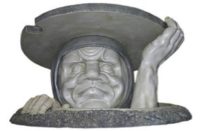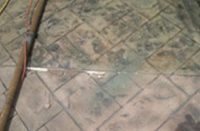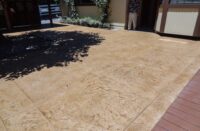
If done right, polished concrete — and other decorative concrete approaches — offer low-maintenance solutions in interior and exterior settings.
That’s “low-maintenance” as opposed to “no-maintenance” or “maintenance-free.”
“We sell polish as ‘maintenance simple,’ not ‘maintenance-free,’” says Shawn Halverson, CEO of Surfacing Solutions Inc. in Temecula, California.
But the reality that polished concrete and decorative concrete installations require some degree of maintenance to retain their appearance and performance present a potential opportunity for the contractor, in the form of maintenance services going forward.
The key word here is “potential.”
The hitch: if the contractor sells the client on a maintenance program going forward, will it pay off for the contractor?

Protecting the investment
On a maintenance contract’s plus side, there’s the obvious: “Maintenance helps to make our work stay looking good and protects the client’s investment,” Halverson says.
For the contractor, long-term maintenance also provides an attractive, functioning portfolio entry to show potential customers.

Matthew Newcomer, project manager with Preferred Global Inc., a flooring, painting and concrete-polishing contracting company in Noblesville, Indiana, also emphasizes the “low-maintenance” label for polished concrete. He says an ongoing maintenance program will prolong the polished concrete’s life and preserve its reflectivity. Clients, he says, may want the contractor to maintain the floors due to lack of equipment or staff.
Owners may not realize how dirt and debris can deteriorate a polished surface, thinking it immune to such wear, Newcomer says. Foot and vehicle traffic — combined with residues like sand, dirt, chemicals and metal shavings — can cause abrasion equivalent to 200-grit sandpaper. Without adequate maintenance, he says, a highly reflective polished floor can be dulled down to a 200-grit finish.
Unlike VCT floor coverings, polished concrete doesn’t require “messy waxes” or wax stripping and reapplication for maintenance, Newcomer says. Facilities can remain open for maintenance and avoid downtime.
Maintaining a decorative concrete installation keeps the project “looking great for many years, which adds value to what we do,” says Emil Gera, owner of Emil J. Gera Concrete Contractor Inc. in Weatherly, Pennsylvania. “It’s also a source of income and keeps good relations with customers, which equates to more referrals.”
The playbook
Newcomer offers an example of a maintenance regimen as outlined by Preferred Global. Key elements include:
- Deep and thorough cleaning using an auto-scrubber and white cleaning pads to remove contaminants that can damage the floor. If needed for heavier dirt, soft-bristle brushes are sometimes used. A mild-pH cleaner is used to remove stubborn and sticky contaminants. Client use of an auto-scrubber for this purpose is suggested on a weekly or even daily basis, depending on traffic.
- Resealing and burnishing on a quarterly or semi-annual basis, depending on traffic. The sealer acts as a sacrificial wear layer, providing a barrier between concrete floor and surface contaminants. Sealer must be replaced due to traffic.
- A comprehensive rejuvenation program, using diamond polishing pads to repolish the floor. As with initial polishing, a series of diamond grits are used in a sequence from 200 to 1,500 grit to return the floor to its original shine and clarity. The good news is that such an extensive restoration program is typically only needed when maintenance is lacking and residues on the floor lead to degradation of the polished surface.
A contractor’s maintenance program addresses the risk of degradation due to owner neglect or use of improper cleaning methods and materials, Newcomer says.
Selling the plan
During initial project discussions with the client, the importance of maintenance gets attention from the get-go, says Gera. He advises clients on what to look for in determining when maintenance is needed and to contact him with any questions.
“If there’s an issue or concern, it’s easier to be safe and explain than to just let it go and see an issue escalate and need major repairs.”
A first step in any maintenance work is determining the types of sealer and color products that were previously used. “This is crucial,” Gera says, as newer sealers may not be compatible with earlier versions. To remove “years of contamination,” the surface should be thoroughly cleaned with a pressure washer, floor scrubber with nylon brush and a strong degreaser.
Then, color issues are addressed, if needed, and the surface dries, usually overnight. A reactivator is applied — a type of solvent that facilitates adhesion of new sealer to existing sealer — followed by a light coat of new sealer.
“We’re seeing much better performance out of the newer generation of sealers. Generally reseals are taking place at four or five years as opposed to two or three,” Gera says.
“One major issue we’re seeing is an incompatibility between the older sealers that are non-VOC compliant and the new, compliant ones. These jobs are making us strip the surface of all the old sealer, and restaining and antiquing along with applying new sealer. These are the jobs costing us money to service.”
Besides the additional time to do the work, Gera says, there’s the challenge of explaining to the customer that it’s costing extra to strip old sealer.

Marketing and pricing
For now, Gera says he restricts sales and marketing of maintenance programs to previous customers, mainly because of sealer incompatibility and not knowing what other installers may have used. With projects of this type, he says, “The only option is to strip the surface and start over.” He’s currently exploring ways to deal more efficiently with such scenarios to potentially expand maintenance services to owners who aren’t past customers.
Halverson says the matter of pricing is extremely important, but the contractor should give the cost a positive spin because of the value maintenance can deliver to the client.
Newcomer says Preferred Global’s maintenance programs are priced on an individual basis, depending on customer needs.
Brent Schmiegelow, owner of American Concrete Concepts in Conway, Arkansas, says the contractor may have to put a hefty price tag on maintenance programs to justify “running around the country” with equipment in tow to fix everything from eroded concrete floor joints to pickle-juice stains. He’s found that owners of big-box and grocery stores soon realize the maintenance program they signed up for “has gotten expensive.”
One possible option for contractors is to limit the scope of an ongoing maintenance program to major repair/restoration work, where it’s worth the investment of both contractor and owner, Schmiegelow says.
Gera says it can be difficult to recoup and charge for all the man-hours to perform proper maintenance, which involves trips back to the site — one to clean and do detail work, and another to reseal.
“Because of this, when we schedule maintenance calls we map out as many as we can that are close to each other.” Invariably, there’s that one that’s out of the way, which costs a half-day’s work.
“I give my customers a ballpark idea of what the maintenance will cost and try to hold to it. I explain to them that their first service is time and materials, and we base future maintenance on this. We usually charge travel to the job in one direction,” a policy that offers the “best way to be fair to both us and the customer,” Gera says.
“I also consider maintenance a type of advertising. We keep the jobs looking great, our customers’ friends and family see this, and it equates to more work and referrals.”
Educating the customer
Newcomer says Preferred Global emphasizes educating the customer on proper floor maintenance, in the form of a detailed pamphlet and a free training session if the customer opts to tackle maintenance in-house. The customer also has the option of signing up for a Preferred Global maintenance program.
Newcomer says the education and training program for customers has “drastically reduced the warranty calls we’ve received as a result of improper maintenance practices.” The training covers cleaning and maintenance functions, including types of brushes, pads and auto-scrubbers to use, and acceptable detergents and cleaners.
Crucial to any maintenance program is the ongoing update and revision of the program, particularly in manufacturing facilities, in response to changes and introduction of chemicals involved in the manufacturing process. Also important are preventative measures such as installing walk-off mats at entrances to catch dirt and debris, cleaning up spills in a timely fashion, and sweeping or mopping daily.
www.acci-us.com
www.geraconcrete.com
www.preferredglobal.net
www.surfacingsolutionsinc.com















